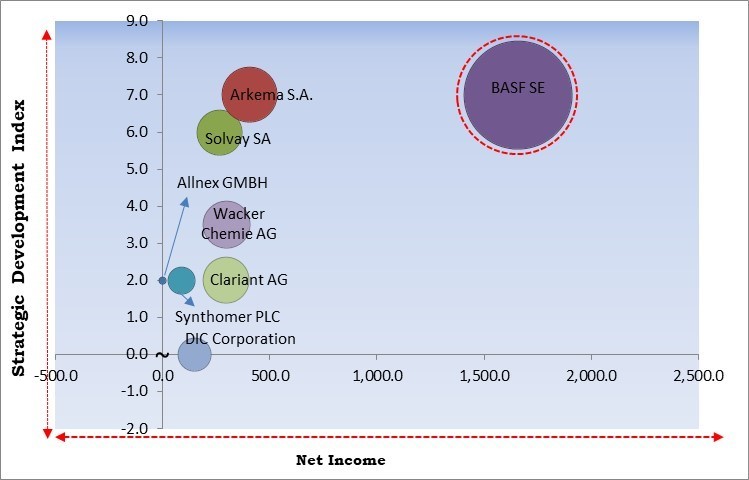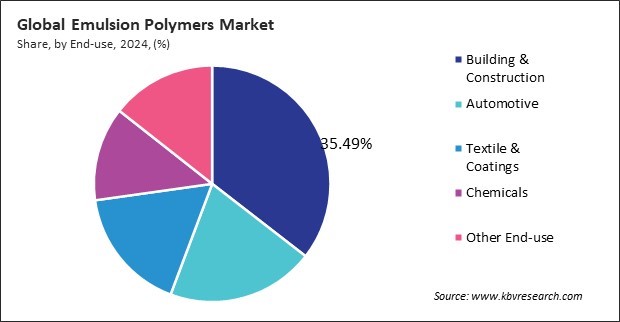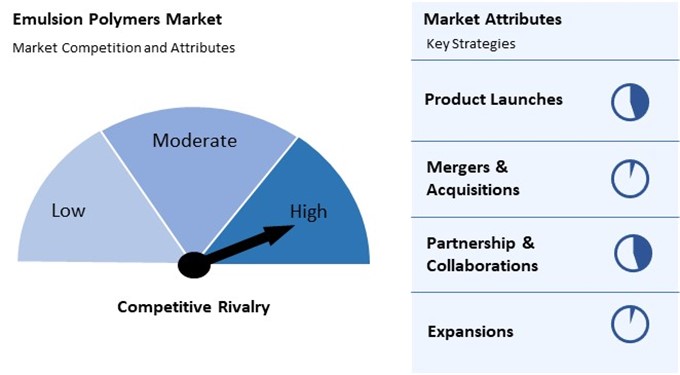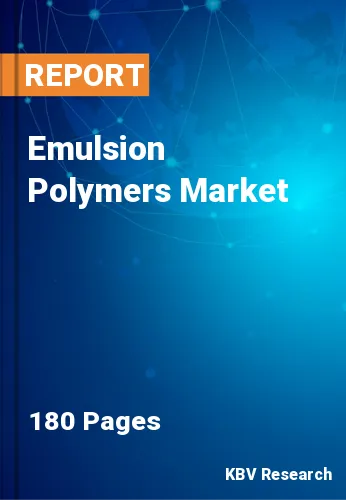“Global Emulsion Polymers Market to reach a market value of USD 52.74 Billion by 2032 growing at a CAGR of 6.2%”
The Global Emulsion Polymers Market size is expected to reach $52.74 billion by 2032, rising at a market growth of 6.2% CAGR during the forecast period.
Emulsion polymers are extensively used in textile finishes and coating formulations for their soft feel, durability, and resistance to water and chemicals. Their role in enhancing fabric quality and performance is critical in the fashion, industrial, and technical textile markets. Growing demand for treated fabrics with specific functionalities, such as stain resistance and water repellence, is driving the uptake of emulsion polymers in this segment.

The major strategies followed by the market participants are Partnerships as the key developmental strategy to keep pace with the changing demands of end users. For instance, In February, 2025, Synthomer PLC teamed up with the University of York, a university to develop next-generation bio-based polymers. This collaboration aims to drive decarbonisation and defossilisation in the chemical industry by creating sustainable polymers from non-food competing feedstocks. The collaboration builds upon previous joint research efforts and is supported by the Engineering and Physical Sciences Research Council (EPSRC). Additionally In January, 2025, Clariant AG teamed up with TER Chemicals, a Chemical wholesale to distribute its comprehensive lubricants portfolio across Central and Eastern Europe. This includes key products like Emulsogen and Genapol emulsifiers, which are vital in applications such as paints, coatings, and lubricants. The collaboration aims to enhance customer access to Clariant’s sustainable solutions in these regions.
Based on the Analysis presented in the KBV Cardinal matrix; BASF SE is the forerunner in the Emulsion Polymers Market. Companies such as Arkema S.A., Wacker Chemie AG, and Clariant AG are some of the key innovators in Emulsion Polymers Market. In June, 2023, BASF SE teamed up with Avient Corporation, a Plastics material and resin manufacturing company to offer colored grades of Ultrason high-performance polymers globally. This collaboration combines BASF’s Ultrason polyarylethersulfones (PAES) with Avient’s expertise in high-temperature color formulations. The collaboration targets industries such as household, catering, electrical & electronics, and healthcare, providing comprehensive technical support from base polymer to final-colored product.

The growing consumer preference for low odor and high-performance paints has emerged as a strong driver of the market. While effective, traditional solvent-based paints release volatile organic compounds (VOCs) that cause unpleasant odors and pose health risks, especially in enclosed environments. On the other hand, emulsion polymers are water-based, significantly reducing VOC emissions and making them ideal for indoor use in homes, hospitals, schools, and offices. Thus, the growing consumer inclination toward safer, low-emission, and efficient coating solutions significantly bolstered the demand for emulsion polymers in the paints and coatings sector.
Additionally, the market is experiencing robust growth due to the rising demand for customized and application-specific polymer solutions. Industries today require polymers with properties precisely engineered to meet performance demands across diverse applications, including adhesives, coatings, sealants, textiles, and paper. Emulsion polymers offer exceptional versatility, enabling manufacturers to fine-tune viscosity, elasticity, drying time, film strength, and water resistance. Hence, as industries increasingly seek performance-specific and application-focused materials, the adaptability of emulsion polymers places them at the forefront of customized formulation trends.
One of the major restraints hampering the growth of the market is the significant capital investment required for technological upgradation. Companies must invest heavily in advanced manufacturing technologies as market demands evolve toward higher-performance polymers and environmentally sustainable processes. These investments include upgrading reactors, automation systems, waste management setups, and quality control laboratories. In conclusion, the substantial financial outlay required for modernization and compliance continues to be a deterrent, especially for small and mid-sized players aiming to scale in the market.
Free Valuable Insights: Global Emulsion Polymers Market size to reach USD 52.74 Billion by 2032
Based on type, the market is characterized into acrylics polymer, styrene-butadiene latex, vinyl acetate polymer, and others. This strong performance can be attributed to the segment’s widespread application in paints, coatings, adhesives, and textiles due to its excellent weather resistance, durability, and adhesion properties. The growing demand for water-based and environmentally friendly coating solutions across various industries has further driven the uptake of acrylics polymers in the market.
By end-use, the market is divided into building & construction, automotive, textile & coatings, chemicals, and others. The increasing use of emulsion polymers in architectural paints, waterproofing solutions, sealants, and cement modification products drives this growth. Low VOC content, strong adhesive properties, and durability make them ideal for sustainable construction practices. Moreover, rapid globalization and infrastructure development projects significantly boost the demand for emulsion polymers in this sector.

On the basis of application, the market is classified into paints & coatings, adhesives & sealants, paper & paperboard, and others. This growth is supported by the rising use of emulsion polymers in pressure-sensitive adhesives, packaging, and construction sealants due to their flexibility, strength, and moisture resistance. The segment benefits from the growing packaging industry and increased use of eco-friendly adhesive solutions across various end-use sectors.

The emulsion polymers market is characterized by intense competition, driven by a wide range of manufacturers offering diverse product portfolios. Key factors influencing competition include product quality, pricing strategies, technological innovation, and customer service. Market participants focus on expanding their product lines with advanced and eco-friendly emulsion polymers to meet the growing demand for sustainable solutions across industries like paints and coatings, adhesives, textiles, and paper. Research and development play a crucial role, as companies aim to enhance polymer performance, improve durability, and reduce environmental impact. Regional manufacturers compete with global players by offering cost-effective solutions tailored to local customer needs. Strategic partnerships, mergers, and acquisitions are common as players aim to strengthen their market position.
Region-wise, the market is analyzed across North America, Europe, Asia Pacific, and LAMEA. The demand in this region is largely fueled by stringent environmental regulations encouraging the use of low-VOC and water-based polymer solutions. Industries such as paints & coatings, adhesives, and automotive in countries like Germany, France, and the UK are adopting emulsion polymers to meet sustainability standards.
| Report Attribute | Details |
|---|---|
| Market size value in 2024 | USD 33.11 Billion |
| Market size forecast in 2032 | USD 52.74 Billion |
| Base Year | 2024 |
| Historical Period | 2021 to 2023 |
| Forecast Period | 2025 to 2032 |
| Revenue Growth Rate | CAGR of 6.2% from 2025 to 2032 |
| Number of Pages | 303 |
| Number of Tables | 394 |
| Report coverage | Market Trends, Revenue Estimation and Forecast, Segmentation Analysis, Regional and Country Breakdown, Competitive Landscape, Porter’s 5 Forces Analysis, Company Profiling, Companies Strategic Developments, SWOT Analysis, Winning Imperatives |
| Segments covered | Type, Application, End-use, Region |
| Country scope |
|
| Companies Included | BASF SE, Synthomer PLC (William Blythe Ltd.), Allnex GMBH (PTT Global Chemical Public Company Limited), Arkema S.A., DIC Corporation, Celanese Corporation, Wacker Chemie AG, Momentive Performance Materials, Inc. (Hexion, Inc.), Solvay SA and Clariant AG |
By Type
By Application
By End-use
By Geography
Our team of dedicated experts can provide you with attractive expansion opportunities for your business.

 Drivers
Drivers
 Restraints
Restraints
 Opportunities
Opportunities
 Challenges
Challenges
